The amount of time you spend creating content is greatly surpassed by the amount of time it takes to go through the rope and get the right people to sign off. Especially if there are multiple stakeholders involved, forget it you are going to be absolutely frustrated at the end. Managing the content approval process on top of social media content creation can make your schedule so full, that you can barely breathe. So to give you some much-needed reprieve, we will tell you how to build a social media content approval process that will save up so much of your time. So, let’s get started!
Why is it Important to have a Social Media Content Approval Process?
A social media content approval process is nothing but a workflow in which social media content is created, reviewed by critical and relevant stakeholders, and posted to the company profiles once the approvals go through.
Now, these content review and approval processes can be quite loopy where the stakeholder offers feedback, the team makes the changes and the process repeats again. This way deadlines are missed, posts do not go out at the proper time, and thus might miss out on opportunities.
To avoid this headache, we can establish a strong marketing content approval system that will ensure your strategy is efficient. Some benefits of having an approval system are as follows:
- Can maintain consistency and stay on track with your content strategy
- Quality maintenance is ensured since the content is scrutinized by multiple sets of eyes
- Everyone involved in creating a social media post is kept in the loop thus making sure no information is lost enroute.
- Since the content goes through many sets of reviews, the post will adhere to your brand guidelines
- Having a marketing content approval process means your team is better capable of collaborating with specialists from other departments through a free video conferencing app as well
- When you have an approval system in place, the posts will be planned and executed well in advance, thus making your content approval workflow all the more efficient.
The Five-Step Fail-Proof Social Media Content Approval Process
Now that you know how a content review and approval process can make your life easier, it is time to sit down and start creating one. Use these 5 steps as a framework and start creating your own social media approval process that works for your business:
1. Get the team and Projects in Order
To get started on your content approval process, you first need to compile a list of your current projects and the teammates who are required to get it done. You also need to think about who will sign off on each of the posts (and it is best to keep it to a minimum because we do not want unnecessary project delays).
Now that you have the relevant information, it is time to assign the related people to the related project. In Predis AI, you can schedule your post and ask for approval from a fellow teammate all within one screen. Cool, right?
When making up this plan, make sure that the workload is split evenly between the resources. When you spread them too thin, you might end up with a low-quality, watered-down product that you do not want to take out to the client. A quick project management course can make it easier to plan tasks, assign roles, and keep approvals on track.
2. Establish Guidelines and Approval Schedules
Since the team and projects are in alignment, we need to figure out the overall quality of the social media content that goes out. Each approver will have a different outlook and quality control standards, which makes it necessary for your brand to have a common guideline that everyone can adhere to.
This also ensures that your brand is represented consistently in every social channel. So develop a document with your brand’s font, colors, tone, voice, and any other standard you want those posts to meet.
It is also crucial to mention what legal compliance principles the posts need to follow and a contingency plan in the event of a violation.
Another, important thing to keep in mind is the approval schedule. What happens after an idea for a post is conceived? Who works on the outline? How long should they work on a post? Who approves the said post and how long should it take? Clearly spell out all these details when you create a workflow.
This way, every person working on the content will know exactly what is expected of them and what their deadlines are. This ensures that the social media approval process does not take more than the stipulated time.
3. Formulate the Content Approval Workflow
Since the workflow is now clear on all fronts, it is now time to set up everything required for it to be implemented smoothly. Some steps you can take are as follows:
- For example, for everyone to stay on the same page from start to end, they all have to have a common platform where they can track these with project management software.
- Once the platform is finalized, you might need a teammate to start creating a content calendar, so that the whole team knows what needs to be done and if any other topics need to be covered.
- You might also have to upload your content guidelines to this platform so that everyone can have easy access to them.
- You can also specify where the status of the content will have to be updated.
Preferably, if you could access all these details from one platform (which fortunately most social media management tools can do) then it would be efficient.
4. Train the users
Once you have the content approval workflow set in stone, you need to be able to communicate your plan clearly to your teammates to eliminate bottlenecks.
Identify key stakeholders, content approvers, content creators, and every relevant person in your team and meticulously train them. Consider using mentorship platforms to offer expert guidance and support, helping your team sharpen their skills. Once their training is done, monitor their usage from time and time and troubleshoot any errors that may arise.
There might be some learning curve before this content approval workflow gets implemented without a snitch. But once it gets done, you will be set for success.
5. Performance Optimization
Even the greatest plans in the world have some pitfalls and so will yours. This will become apparent once your process hits the ground and starts running.
An intuitive user interface helps your team adopt the project management software with less friction.
You might not have thought about creating a common repository for all your content.
Maybe a proper content updating system is not in place. Maybe a proper content updating system is not in place, making it harder to organize the content of your website effectively.
It could be anything and everything. Keep your eyes and ears wide open to identify any issues that your team might be facing and work towards rectifying them.
You can also ask users what feedback they have regarding this approval system and if had the chance, what would they change. This might get you some unique suggestions that might have slipped your notice.
Signs that your Social Media Content Approval Process is Working
Okay, you have an approval system in place. Now what?
Now, you figure out if you are reaping the benefits of all your hard work.
- You wake up to a less full email inbox. Back when you did not have an approval process, you would have gotten tons of emails from stakeholders asking for status, changes, or something else. But now that a pipeline is a setup, everyone is aligned and no one is spamming you.
- You do not have to guess which stakeholder has to sign off on your post. Because, since the project inception everything will be clear – who are the content creators and who are the approvers.
- You do not have to take up every feedback. Since there are set guidelines on what needs to be followed, you have some autonomy to decide what feedback to go with and what to ignore.
- Your content creation process is less stressful. Even though you sometimes have to work on a tight schedule, this is a rare occurrence. Since this social media approval process has been implemented, your content strategy has been well-planned, and you will create content faster.
- You see a significant decline in errors. The downside of working on a tight schedule is that you may make mistakes along the way and sometimes may go unnoticed. But with this social media content approval process in place, you would have kissed that worry goodbye.
- You have time to optimize your post. When posts are pre-planned and executed, you have loads of time to optimize and get them to their best version.

Automate Your Content Approval System with Predis AI
With Predis AI you can create your social media content, collaborate with your team, schedule the posts, and get approval from stakeholders all in one place. Let us show you how to get started.
- First, sign up for Predis AI.
- Once you have signed up, you can have AI generate your posts or you can design them on your own and upload them. This way you get to see all your posts in one place.
- You can get a built-in content calendar where you can visualize your whole month’s posts.
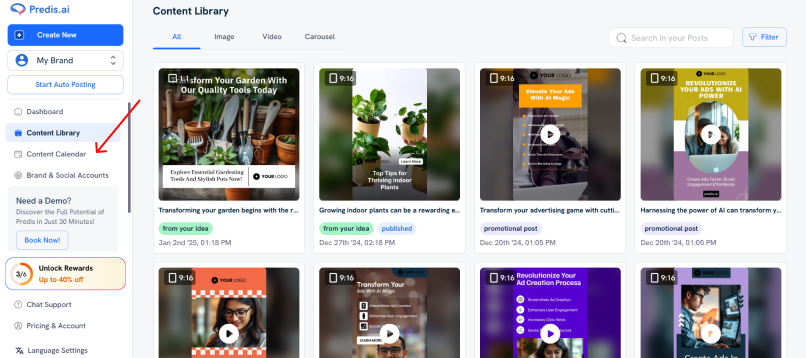
You can see the status of the posts from the color code below the screen.
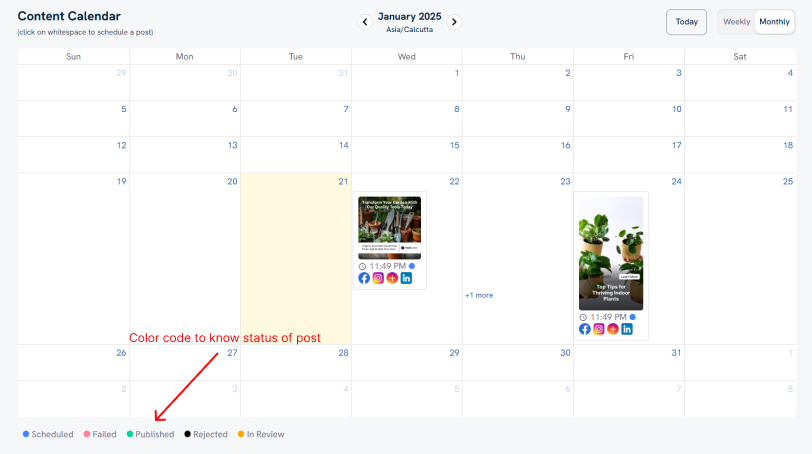
- You can schedule the post directly from the content library. Click on the post that you want to schedule.
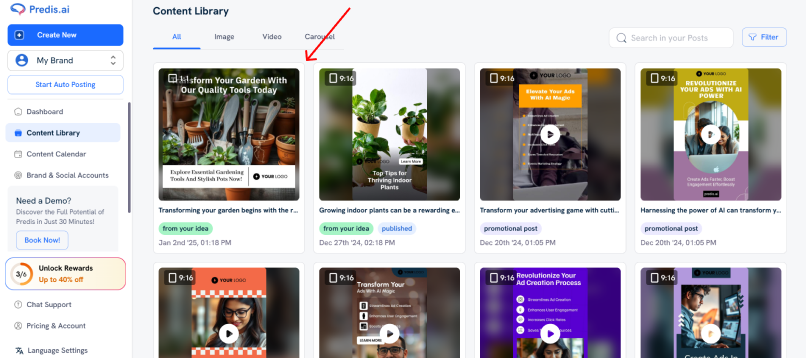
- Hit “Publish”

- Select the platform you want to publish on and click “Continue”
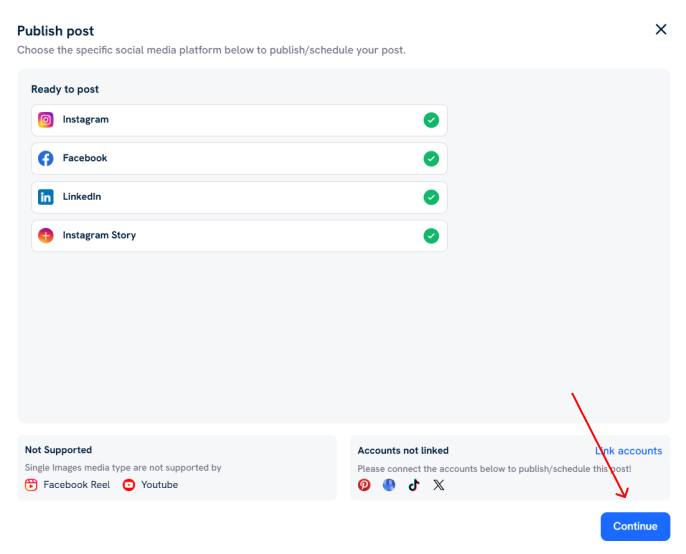
- You can select the date and time that you want the post to go up and hit “Schedule Post”
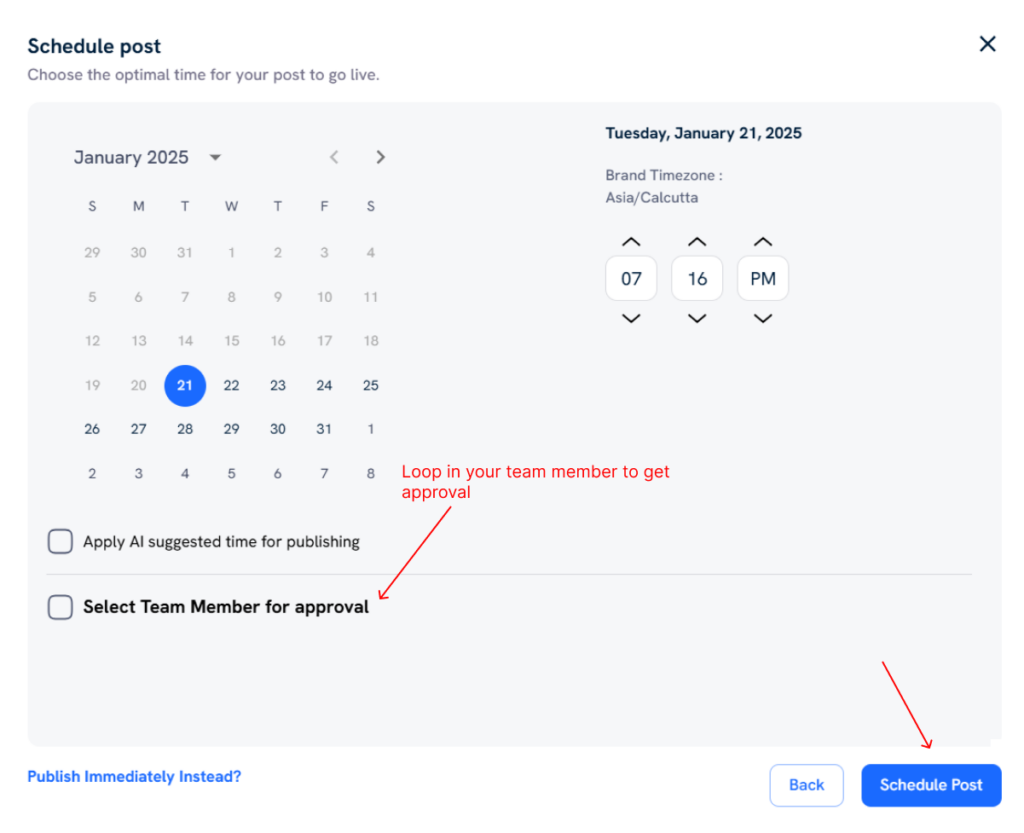
You can include the person you want approval from at this stage. Thus making the social media approval process easy.
Thus, your whole social media approval process can be handled from one platform itself. So sign up now and make your life easier.
Final Thoughts
A huge portion of social management involves making content and getting it approved. If you can automate a huge chunk of it, you are freeing up a lot of time you can spend on other more productive work.
Plus, having a social media content approval process ensures the team is aligned and hits deadlines consistently. So, what are you waiting for, get started and take a step towards efficiency.
FAQ
A social media content approval process is nothing but getting approval for social media posts through a seamless workflow. This will help align the team and maintain consistency.
When you have a well-thought-out approval process in place, your content generation and posting becomes seamless. Your whole team will be aligned with the goals and communication between them will be clear. This ensures a stress-free content creation process.
Many project management software and social media content management tools allow you to partially automate your processes. With the right amount of planning, you can glide through the review process and save a lot of time.
















